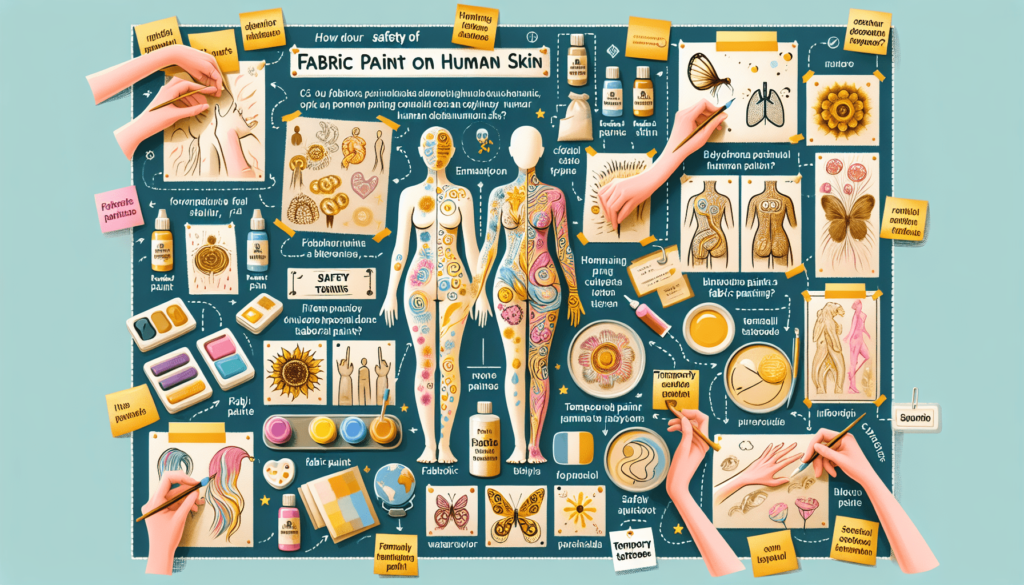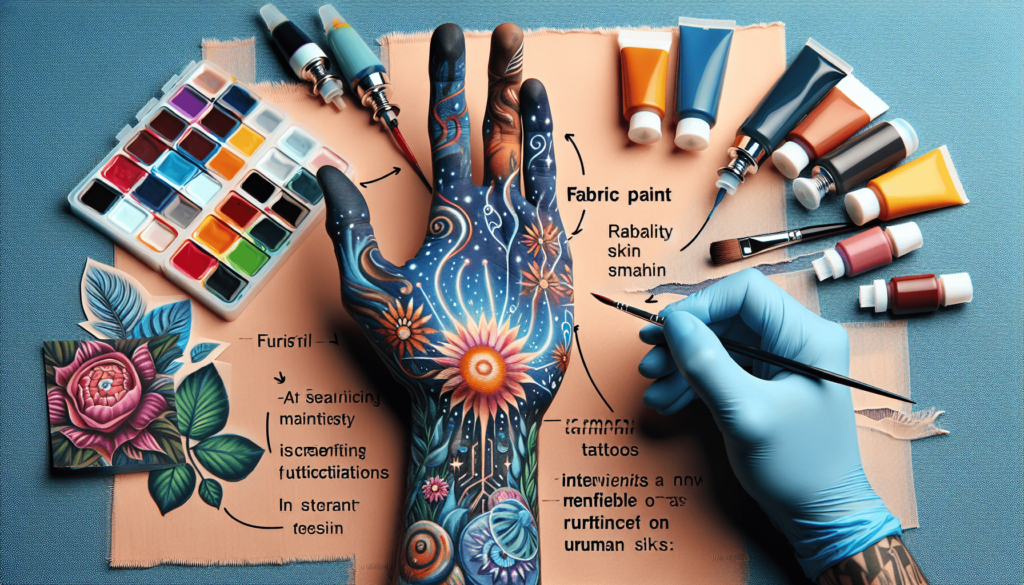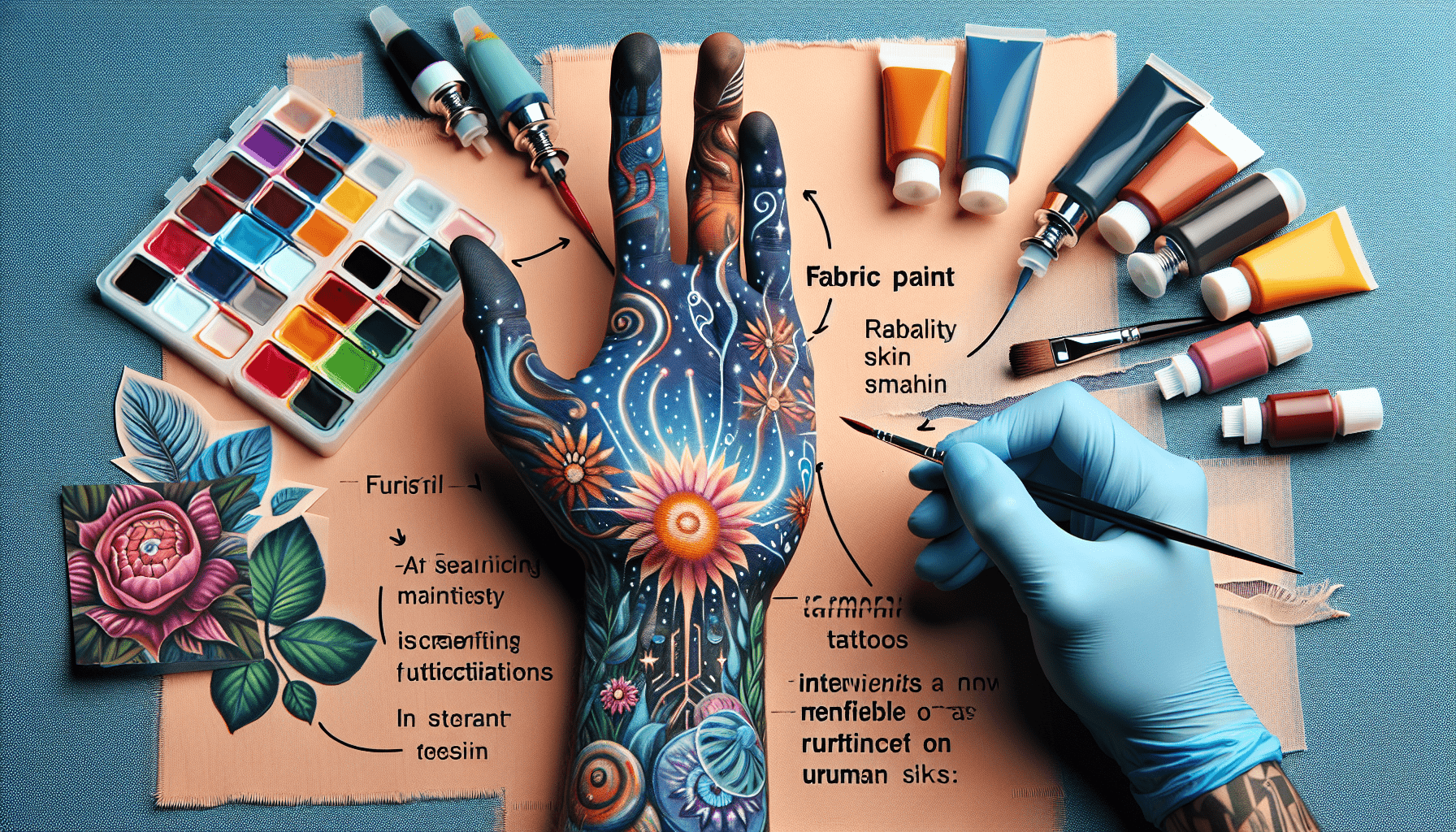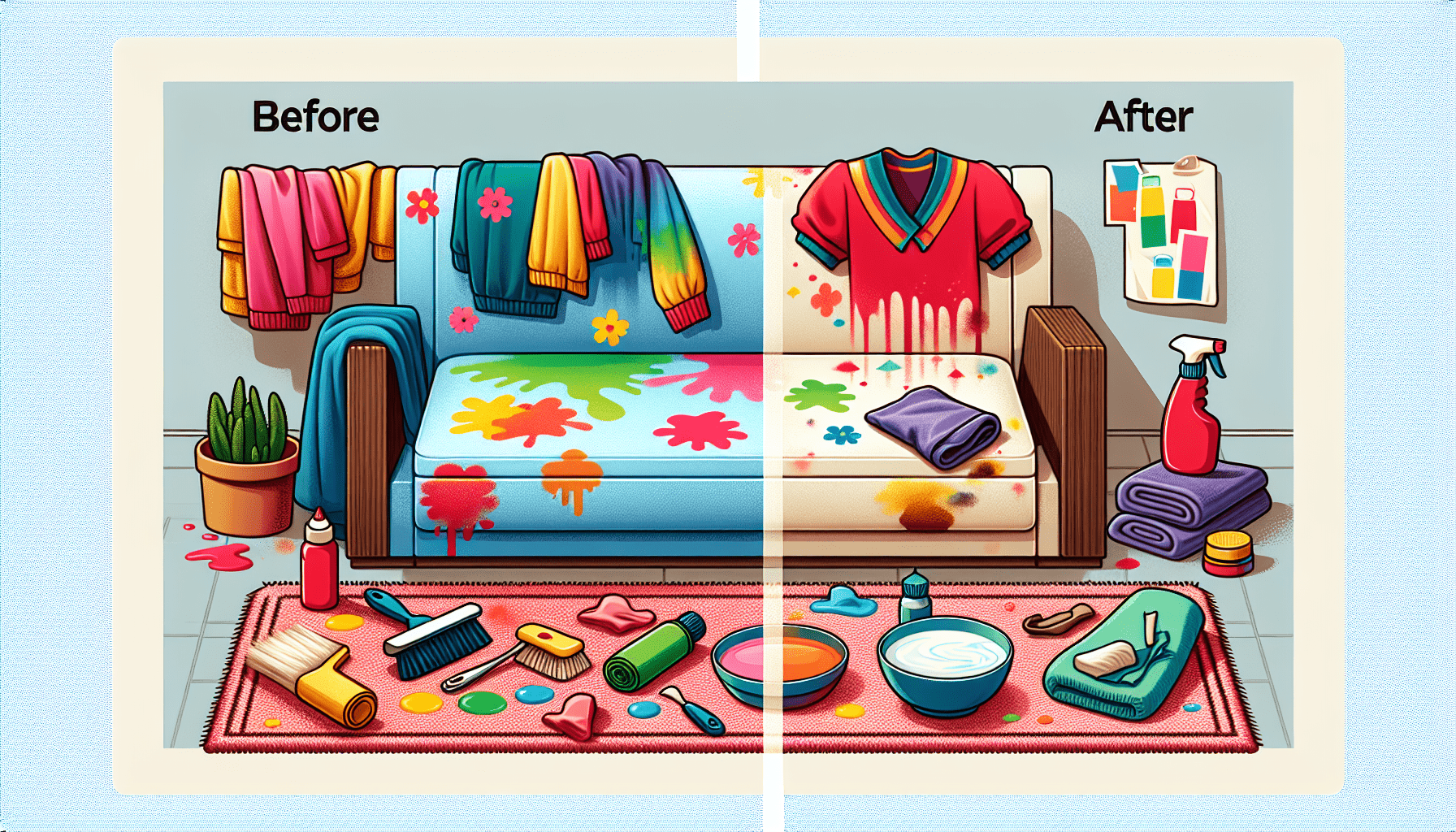Fabric paint is a popular choice for adding vibrant colors and creative designs to clothing and accessories. However, before you begin painting directly on your skin, it’s crucial to consider the safety implications. This article explores the question of whether fabric paint is safe for skin application, discussing factors such as ingredients, potential risks, and alternative options. By understanding the potential effects of fabric paint on your skin, you can make informed decisions to ensure both your artistic expression and personal safety.
What is Fabric Paint?
Definition of fabric paint
Fabric paint is a type of paint specially formulated for use on textiles, such as clothing, upholstery, and accessories. Unlike regular paint, fabric paint is designed to adhere well to fabric fibers and withstand washing and wear. It is commonly used for creating designs, patterns, or artwork on fabrics.
Types of fabric paint
There are various types of fabric paint available in the market, each with its unique characteristics and applications. The most common types include:
-
Acrylic fabric paint: This type of fabric paint is water-based and offers excellent color saturation and durability. It is versatile and can be used on a wide range of fabric materials.
-
Puff paint: Puff paint is a fabric paint that puffs up when heat is applied, creating a textured or three-dimensional effect. It is often used for adding dimension to fabric designs.
-
Metallic fabric paint: As the name suggests, metallic fabric paint contains metallic pigments that give a shiny, metallic finish to fabric. It is commonly used for creating accents or embellishments on garments.
-
Glow-in-the-dark fabric paint: This type of fabric paint contains phosphorescent pigments that glow when exposed to light. It is popular for creating fun and eye-catching designs on fabrics.
Ingredients in Fabric Paint
Common ingredients in fabric paint
The composition of fabric paint may vary depending on the brand and type. However, there are several common ingredients that can be found in most fabric paints. These ingredients include:
-
Pigments: Pigments are responsible for giving fabric paint its color. They can be synthetic or derived from natural sources.
-
Binders: Binders help the paint adhere to fabric fibers and provide durability. Acrylic polymer is a commonly used binder in fabric paint.
-
Solvents: Solvents are used to make fabric paint easier to apply and to help it dry quickly. Water is the most commonly used solvent in water-based fabric paints.
-
Additives: Additives are used to enhance certain properties of fabric paint. For example, thickeners may be added to create a more textured effect, while drying agents may be used to speed up the drying process.
Potential risks of fabric paint ingredients
While fabric paint is generally safe to use on fabrics, there are some potential risks associated with its ingredients, particularly when used on the skin. Some fabric paint ingredients may cause skin irritation, allergic reactions, or other adverse effects. It is important to consider these risks and take appropriate precautions when using fabric paint on the skin.

Skin Safety Considerations
Using fabric paint on the skin
Fabric paint is not specifically intended for use on the skin, and using it directly on the skin carries certain risks. However, some individuals may choose to use fabric paint for temporary skin decoration or body art purposes. If you decide to use fabric paint on the skin, it is essential to follow certain safety guidelines.
-
Perform a patch test: Before applying fabric paint to a larger area of the skin, it is recommended to first perform a patch test on a small, inconspicuous area. This helps to check for any adverse reactions or sensitivity to the paint.
-
Clean and dry the skin: Ensure that the skin is clean and dry before applying fabric paint. Removing any oils, lotions, or dirt from the skin can help improve paint adhesion and reduce the risk of skin reactions.
-
Use appropriate tools and techniques: When applying fabric paint on the skin, it is best to use clean brushes or sponges designed for body art. Avoid using fingers or dirty brushes, as they may introduce bacteria or other contaminants to the skin.
Potential side effects or allergic reactions on the skin
Using fabric paint on the skin can potentially lead to side effects or allergic reactions. Some individuals may be more susceptible to these reactions than others. Common side effects of using fabric paint on the skin can include:
-
Skin irritation: Fabric paint may cause redness, itchiness, or a burning sensation on the skin. This could be due to certain ingredients or the presence of allergens.
-
Allergic reactions: Some individuals may be allergic to certain ingredients in fabric paint, such as pigments or binders. Allergic reactions can range from mild irritation to more severe symptoms like hives or swelling.
If you experience any discomfort or adverse reactions after using fabric paint on the skin, it is important to remove the paint immediately and consult a healthcare professional if necessary.
Regulations and Labels
Safety regulations for fabric paint
Fabric paint manufacturers are required to comply with safety regulations and standards to ensure the products’ safety for consumers. These regulations may vary depending on the country or region. In the United States, fabric paints fall under the category of art materials, and their safety is regulated by the Consumer Product Safety Commission (CPSC) and the labeling requirements of the Art and Craft Materials Institute (ACMI).
The CPSC enforces regulations that restrict the presence of hazardous substances in art materials, including fabric paint. These regulations aim to minimize potential health risks associated with exposure to toxic components.
Reading labels for fabric paint safety
When using fabric paint, it is crucial to read and follow the instructions and safety information provided on the product labels. Fabric paint labels typically include important details, such as:
-
Instructions for use: The labels provide guidance on how to use the fabric paint correctly and safely. It is essential to follow these instructions to ensure the best results and minimize any potential risks.
-
Safety precautions: Fabric paint labels may contain warnings or precautions regarding skin contact, eye contact, or inhalation of paint fumes. These precautions should be carefully observed to minimize the risk of adverse effects.
-
Hazard warnings: Labels may indicate if the fabric paint contains any hazardous substances or allergens. This information can help individuals with known sensitivities or allergies avoid products that may trigger a reaction.
By carefully reading and understanding fabric paint labels, users can make informed decisions about their safety and choose products that meet their specific needs and preferences.

Precautions and Safety Measures
Testing a patch of skin before use
Before applying fabric paint to a larger area of the skin, it is advisable to perform a patch test on a small, inconspicuous area. This can help identify any potential skin reactions or allergies to the paint. To conduct a patch test, follow these steps:
-
Select a small area of skin on the inner arm or behind the ear.
-
Apply a small amount of fabric paint to the patch test area and allow it to dry completely.
-
Monitor the patch test area closely for at least 24 hours. Look for any signs of redness, itchiness, or irritation.
If no adverse reactions occur during this period, it is generally safe to use the fabric paint on a larger area of the skin.
Avoiding sensitive areas of the skin
When using fabric paint on the skin, it is important to avoid applying it to sensitive areas or mucous membranes, such as around the eyes, nose, or mouth. These areas are more prone to irritation or allergic reactions, and contact with fabric paint could exacerbate these risks.
Additionally, individuals with pre-existing skin conditions or allergies should exercise extra caution when considering the use of fabric paint on the skin. It is recommended to consult with a dermatologist or healthcare professional to determine the suitability and safety of using fabric paint in such cases.
Proper removal of fabric paint from the skin
After using fabric paint on the skin, it is crucial to properly remove it to minimize potential skin irritation or residual effects. To remove fabric paint from the skin, follow these guidelines:
-
Gently wash the painted area with mild soap and warm water.
-
Use a soft cloth or sponge to gently rub the paint off the skin. Avoid scrubbing vigorously, as this may irritate the skin.
-
Rinse the area thoroughly with water to remove any remaining traces of paint.
-
Moisturize the skin with a gentle, fragrance-free moisturizer to help soothe any potential dryness or irritation.
If any paint residue persists or if the skin shows signs of irritation or allergic reaction after removal, seek medical advice.
Alternatives to Fabric Paint
Other safe options for skin decoration
While fabric paint can be used for temporary skin decoration, there are alternative products available that are specifically formulated for use on the skin. These skin-safe options offer a reduced risk of adverse reactions or skin irritation. Some popular alternatives to fabric paint for skin decoration include:
-
Face paint: Face paint is a type of cosmetic-grade paint specifically designed for use on the face and body. It is available in a wide range of colors and finishes, and many products are formulated to be hypoallergenic and non-toxic.
-
Body markers: Body markers are markers or pens designed for drawing or writing directly on the skin. These markers are usually water-based and washable, making them a safe and convenient option for temporary skin decoration.
-
Henna: Henna is a natural dye derived from the henna plant. It has been used for centuries for body art and temporary tattoos. However, it is important to note that some commercially available henna products may contain synthetic additives, so it is advisable to choose pure, natural henna from reputable sources.
Temporary tattoos and body paints
Temporary tattoos and body paints are another popular choice for individuals looking to decorate their skin temporarily. These products come in various forms, including transfers, stencils, and freehand paints. Temporary tattoos are applied to the skin using water, while body paints are usually applied with brushes or sponges.
Temporary tattoos and body paints are typically formulated to be safe for use on the skin. They are often made with skin-friendly ingredients and are designed to be easily removable without causing any long-term effects or damage to the skin.
Professional Recommendations
Advice from professional body artists or makeup artists
When it comes to using fabric paint on the skin, professional body artists and makeup artists can provide valuable insights and recommendations. These individuals often have extensive experience working with various cosmetic and body art products and can offer guidance on safe and effective ways to use fabric paint on the skin.
Professional body artists and makeup artists may recommend the following tips when using fabric paint on the skin:
-
Choose high-quality products: Opt for fabric paint brands that are widely used and trusted by professionals. These brands often prioritize safety and quality in their formulations.
-
Thin layers are key: Apply fabric paint to the skin in thin, even layers. Thicker layers may take longer to dry and could increase the risk of cracking or peeling.
-
Allow ample drying time: Ensure that each layer of fabric paint is fully dry before applying subsequent layers or before coming into contact with clothing or other surfaces. This helps to prevent smudging or transferring of the paint.
Dermatologist opinions on fabric paint usage on skin
While fabric paint is not typically intended for use on the skin, dermatologists can provide valuable insights on its potential risks and safety considerations. Dermatologists specialize in skin health and can assess the compatibility of various products with different skin types and conditions.
A dermatologist’s opinion on using fabric paint on the skin may vary. Some dermatologists may advise against using fabric paint directly on the skin due to the potential risks of skin irritation or allergic reactions. Others may recommend alternative skin-safe options for temporary skin decoration.
If you have any concerns or questions about the safety of using fabric paint on your skin, it is advisable to consult with a dermatologist for personalized advice and recommendations.
Safe Usage Tips for Fabric Paint on Skin
Choosing non-toxic and skin-safe fabric paints
When using fabric paint on the skin, it is crucial to choose non-toxic and skin-safe options. Look for fabric paints that are specifically labeled as safe for skin contact. These paints are typically formulated with ingredients that minimize the risk of skin irritation or allergic reactions.
Pay attention to product details such as:
-
Non-toxic or safe for skin labels: Look for fabric paints that are clearly labeled as non-toxic and safe for skin use. This indicates that the product has been formulated to minimize potential health risks.
-
Hypoallergenic formulations: Some fabric paints are marketed as hypoallergenic, meaning they are less likely to cause allergic reactions. Choosing hypoallergenic options may be beneficial for individuals with known sensitivities or allergies.
-
Reviews or recommendations: Read reviews or seek recommendations from others who have used the fabric paint for skin decoration. Their experiences and feedback can provide insights into the safety and performance of specific products.
Proper application techniques and tools
To ensure safe and successful use of fabric paint on the skin, it is important to use proper application techniques and tools. Follow these guidelines for optimal results:
-
Clean and prepare the skin: Before applying fabric paint, clean and dry the skin thoroughly. Removing oils and dirt helps the paint adhere better and minimizes potential skin reactions.
-
Apply in thin layers: Apply fabric paint in thin, even layers to achieve a smooth and uniform finish. Avoid overloading the brush or sponge with paint, as this may result in clumps or smudging.
-
Allow sufficient drying time: Allow each layer of fabric paint to dry completely before applying additional layers or coming into contact with clothing or other surfaces. This helps to avoid smudging or transferring of the paint.
-
Clean brushes or tools: After each use, clean brushes or tools thoroughly to remove any residual paint. Bacteria or paint residue left on brushes can cause contamination and potential skin issues in future uses.
By following these safe usage tips, individuals can minimize the potential risks associated with using fabric paint on the skin and create beautiful, temporary skin decoration designs.
Case Studies and Experiences
Real-life experiences of using fabric paint on skin
Real-life experiences of individuals who have used fabric paint on the skin can provide valuable insights into its safety and effectiveness. Reading about others’ experiences can help individuals make informed decisions and learn from their successes and challenges.
Some individuals may have positive experiences with using fabric paint on the skin, reporting no adverse effects or skin reactions. However, it is important to note that everyone’s skin is different, and what works for one person may not work for another. Skin sensitivity, allergies, and individual reactions can vary greatly.
Tips and tricks from experienced users
Experienced users of fabric paint on the skin often develop their own tips and tricks for achieving the best results while minimizing potential risks. These tips and tricks can come from individuals who have successfully used fabric paint for skin decoration multiple times.
Some common tips and tricks shared by experienced users include:
-
Start with a clean canvas: Ensure that the skin is clean and free from any lotions or oils before applying fabric paint. This helps the paint adhere better and prevents potential reactions.
-
Practice on non-sensitive areas: If you are new to using fabric paint on the skin, it may be beneficial to practice on non-sensitive areas, such as the arms or legs, before attempting more visible areas. This allows you to become familiar with the paint’s behavior and assess any potential skin reactions.
-
Take breaks between layers: Applying multiple layers of fabric paint can create depth and dimension in designs. However, it is important to take short breaks between layers to allow the previous layer to dry fully. This prevents smudging or unintentional blending of colors.
-
Consider using stencils or templates: Using stencils or templates can help achieve precise and intricate designs. They provide a guide for applying the fabric paint, making it easier for beginners or those with less artistic experience.
By learning from the experiences and advice of experienced users, individuals can improve their own techniques and outcomes when using fabric paint on the skin.
Conclusion
After considering various aspects of fabric paint usage on the skin, it is evident that using fabric paint on the skin carries some risks and considerations. Fabric paint is primarily designed for use on fabrics and not directly on the skin. However, for individuals who choose to use fabric paint for temporary skin decoration purposes, it is crucial to take precautions, perform patch tests, and select non-toxic and skin-safe options.
While some individuals may have positive experiences with using fabric paint on the skin, others may experience side effects or allergic reactions. It is essential to be aware of your own skin’s sensitivities and consult a dermatologist if you have any concerns.
As with any product applied to the skin, it is important to prioritize safety, read and follow instructions and labels, and make informed decisions. By considering alternative skin-safe options and taking necessary precautions, individuals can enjoy temporary skin decoration while minimizing potential risks to their skin health.



